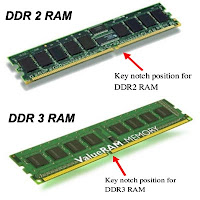Most desktops and notebooks use one of four popular types of dynamic random access memory (DRAM) for the main system memory.
Single data rate (SDR) SDRAM is the older type of memory, commonly used in computers prior to 2002.
Double data rate (DDR) SDRAM hit the mainstream computer market around 2002 and is a straightforward evolution from SDR SDRAM.
The most significant difference between DDR and SDR is that DDR reads data on both the rising and falling edges of the clock signal, enabling a DDR memory module to transfer data twice as fast as an SDR memory module.
Systems implementing the follow-on technology to DDR, called DDR2 began to appear in mid-2004. DDR2 achieves speeds beyond that of DDR, delivering bandwidth of up to 8.5 GB per second. Frequently, DDR2 based systems can use memory installed in pairs to run in "dual channel mode" to increase memory throughput even further.
The latest generation of memory technology, DDR3, began to appear in systems in late 2007. DDR3 is an evolutionary step beyond DDR2 and operates at lower voltages, thereby consuming less power, and can transfer data at rates up to 12.8 GB per second. Typically, DDR3 based systems can address memory modules in banks of 1, 2 or 3. If a system supports it, installing memory in matched sets of 2 or 3 modules (dual channel or triple channel modes) will deliver greatly increased memory performance over running a single memory module by itself.
Generally speaking, motherboards are built to support only one type of memory. You cannot mix and match SDRAM, DDR, DDR2, or DDR3 memory on the same motherboard in any system. They will not function and will not even fit in the same sockets.
Single data rate (SDR) SDRAM is the older type of memory, commonly used in computers prior to 2002.
Double data rate (DDR) SDRAM hit the mainstream computer market around 2002 and is a straightforward evolution from SDR SDRAM.
The most significant difference between DDR and SDR is that DDR reads data on both the rising and falling edges of the clock signal, enabling a DDR memory module to transfer data twice as fast as an SDR memory module.
Systems implementing the follow-on technology to DDR, called DDR2 began to appear in mid-2004. DDR2 achieves speeds beyond that of DDR, delivering bandwidth of up to 8.5 GB per second. Frequently, DDR2 based systems can use memory installed in pairs to run in "dual channel mode" to increase memory throughput even further.
The latest generation of memory technology, DDR3, began to appear in systems in late 2007. DDR3 is an evolutionary step beyond DDR2 and operates at lower voltages, thereby consuming less power, and can transfer data at rates up to 12.8 GB per second. Typically, DDR3 based systems can address memory modules in banks of 1, 2 or 3. If a system supports it, installing memory in matched sets of 2 or 3 modules (dual channel or triple channel modes) will deliver greatly increased memory performance over running a single memory module by itself.
Generally speaking, motherboards are built to support only one type of memory. You cannot mix and match SDRAM, DDR, DDR2, or DDR3 memory on the same motherboard in any system. They will not function and will not even fit in the same sockets.
via-sadop


No comments:
Post a Comment